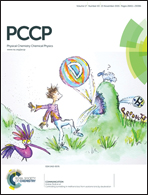The mechanism of water/ion exchange at a protein surface: a weakly bound chloride in Helicobacter pylori apoflavodoxin†
Abstract
Binding/unbinding of small ligands, such as ions, to/from proteins influences biochemical processes such as protein folding, enzyme catalysis or protein/ligand recognition. We have investigated the mechanism of chloride/water exchange at a protein surface (that of the apoflavodoxin from Helicobacter pylori) using classical all-atom molecular dynamics simulations. They reveal a variety of chloride exit routes and residence times; the latter is related to specific coordination modes of the anion. The role of solvent molecules in the mechanism of chloride unbinding has been studied in detail. We see no temporary increase in chloride coordination along the release process. Instead, the coordination of new water molecules takes place in most cases after the chloride/protein atom release event has begun. Moreover, the distribution function of water entrance events into the first chloride solvation shell peaks after chloride protein atom dissociation events. All these observations together seem to indicate that water molecules simply fill the vacancies left by the previously coordinating protein residues. We thus propose a step-by-step dissociation pathway in which protein/chloride interactions gradually break down before new water molecules progressively fill the vacant positions left by protein atoms. As observed for other systems, water molecules associated with bound chloride or with protein atoms have longer residence times than those bound to the free anion. The implications of the exchange mechanism proposed for the binding of the FMN (Flavin Mononucleotide) protein cofactor are discussed.


 Please wait while we load your content...
Please wait while we load your content...